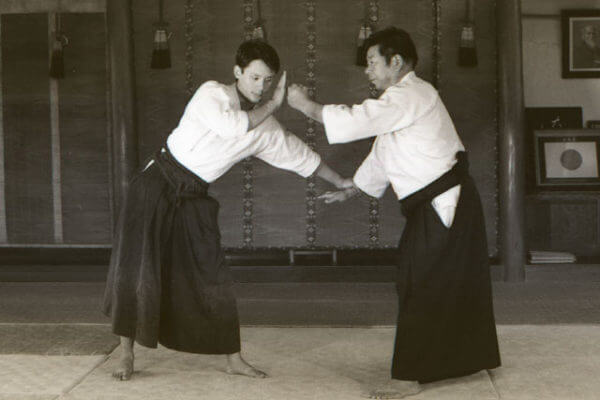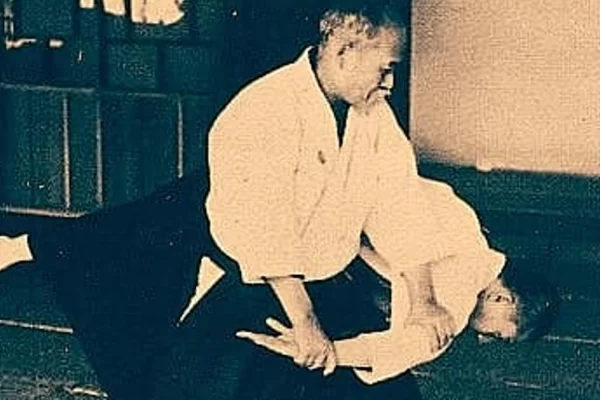Introduction
If you’ve landed on this page, you’re probably interested in studying Aikido. Maybe you’re brand new to Aikido, or perhaps you’ve practiced elsewhere and you’re looking for a new home. Maybe you’re happy practicing where you are, but you’d like to try cross training in Iwama-Ryu Aikido. In any case, you’re welcome to join us. We work hard to make Aikido training accessible to anyone regardless of age, gender or physical condition. Should you choose to train with us, your first week of training is free.
How to Get Started?
If you’re local to the Colorado Springs area, the easiest way to get started is to come visit us during class hours. We welcome visitors. You’re welcome to either come watch class or just jump right in and join us for practice. Loose fitting clothing (a T-shirt and sweat pants, for example) works just fine for your first few weeks of practice. If you’d like to try a few classes before committing to longer term study your first week is free. If you still aren’t sure after the first week, we’re pretty open to arranging a longer trial period. We also offer a significantly discounted beginner’s package that includes three months of dues and a uniform. If you have a family member that you’d like to study Aikido with, we offer a significant family discount for any additional family members. If you have questions about Aikido, or our dojo, we answer emails (info@cos-aikido.com) and phone calls promptly! Our dojo’s goal is to make Aikido practice available to any sincere person that walks through our door! Getting on the mat for the first time can be a challenging experience. We’ve been conditioned by TV and movies to expect a martial arts school to be an intimidating environment. We work hard to make sure our dojo is a welcoming environment for everyone.
Why Choose our Dojo?
There are a few Aikido dojos here in Colorado Springs. It can be difficult, especially if you’re a new student, to understand the differences between both dojos and styles of Aikido. What makes our dojo a good choice?
- We focus on teaching a single style of Aikido, and we have a clearly defined curriculum.
- We offer more classes per week than any other dojo in the area.
- Our curriculum focuses on building a strong foundation, including a well defined weapons curriculum.
- All of our instructors hold rank from the Aikikai and are certified to teach Aikido weapons. The rank we award is recognized globally.
- We have a clearly defined lineage that includes direct regular training with our teachers. Our lineage is directly traceable back to Morihei Ueshiba O-Sensei.
- Our instructional staff regularly attends Aikido seminars globally. We believe that Aikido is a life-long learning experience.
- We are the only Traditional, or Iwama-Ryu, Aikido dojo in the Colorado Springs region.
- Our Chief Instructor has over 30 years of experience practicing and teaching Aikido, with more than 25 years experience practicing Iwama-Ryu Aikido.
- Our focus is on technical development and on walking the path of Morihei Ueshiba O-Sensei, as preserved by Morihiro Saito Shihan. We save the philosophical discussions for beer night! We believe that the “internal” benefits of Aikido are realized through consistent training.
- The first week of training, up to five classes, is free. We’re open to extending trial periods for people with constrained schedules.
What is Aikido?
Aikido is a traditional Japanese martial art that focuses largely on using joint locks and throws to manage an attacker. Aikido’s founder, Morihei Ueshiba O-Sensei, studied and mastered several martial arts. O-Sensei hybridized a new art, initially called “Aiki Budo”, from these arts eventually creating Aikido. Daito-Ryu Aikijujitsu is one of the more prominent influences. O-Sensei also incorporated a philosophical foundation that is, among other things, focused on doing as little harm as possible to an attacker.
Traditional Aikido of Colorado Springs teaches and practices Aikido as a martial art. However, regular long term Aikido practice brings much greater benefit than just self defense. Some of these benefits include:
- Practical self defense skills
- Improved balance and coordination
- An improved sense of timing and distance
- Improved posture, flexibility and overall conditioning
- A greater awareness of your physical body and it’s relationship to the space around you
- The ability to fall both spontaneously and safely
We use a progressive teaching methodology that gradually increases the intensity of practice as students progress in their ability to safely attack and receive technique. We work toward cooperatively increasing the intensity of attacks and responses in a safe and supportive environment. This approach supports accessible training for everyone, regardless of age, gender, or physical condition. We tailor daily practice to the ability of the students on the mat, fostering cooperative improvement for all students.
The Aikido We Practice…
We practice Traditional, or Iwama-Ryu (岩間流), Aikido. Iwama is a small farming town located about 100 km north east of Tokyo. After founding the Kobukan Dojo (later renamed the Aikikai Hombu Dojo) in Tokyo in 1931, O-Sensei retired to Iwama. In 1942, O-Sensei built a small dojo and a shrine, the Aiki Jinja, honoring the Art of Aikido. The dojo, originally called the “Aiki Shuren Dojo” is still in use today. The Iwama dojo is the birthplace of Aikido.
We practice and teach the Aikido handed down by Morihiro Saito Shihan. Saito Sensei spent 23 years practicing directly with O-Sensei in Iwama. For much of that time, Saito Sensei lived as an uchideshi, or live-in student at the Iwama dojo. Saito Sensei was a world-class Aikido technician, and an expert in Aikido weapons (Aiki-ken and Aiki-Jo) as taught by O-Sensei. O-Sensei, just prior to his death, named Morihiro Saito Sensei as the head of the Iwama Dojo and the Guardian of the Aiki Jinja. Saito Sensei spent the rest of his life faithfully preserving the Aikido he learned directly from the Founder. He organized and codified both the taijutsu (empty hand techniques) and the weapons curriculum, and left behind a significant legacy supporting those of us that desire to follow in O-Sensei’s footsteps. Our teachers are direct, long-term, students of Morihiro Saito Shihan.
What Makes Iwama-Ryu Aikido Different?
Iwama-Ryu Aikido is one of the most technically rich styles of Aikido, with over 600 fundamental techniques, or Kihon Waza. Our teaching style focuses on building a strong “foundation”, consisting of a proper stance, proper posture, and proper execution of basic techniques. Iwama-Ryu Aikido emphasizes the inseparable relationship between taijutsu (empty hand techniques) and weapons. Weapons practice is an important part of our practice. We are the only dojo in the Colorado Springs region teaching the Iwama style weapons curriculum. We also develop strong ukemi (falling) skills, including both realistic attacks and the incorporation of modern attacks. While Aikido isn’t principally a “punching and kicking” art, Atemi, or “striking” is an important part of almost every Iwama Aikido technique. We also teach both Kaeshi-waza (reversal techniques) and Henka-waza (adaptive techniques).
Visitors/Observers
Visitors and observers are welcome at any time! If you can arrive before class, we typically arrive about 30 minutes before class starts. If you can’t make it and you arrive after class starts, please have a seat, and as soon as we’re able, we’ll introduce ourselves and try to answer any questions you might have. Please feel free to email us, or give us a call, as well. Our FAQ is also a pretty good place to look for answers to common questions.
Additional Reading
Form in Aikido
Over the years I’ve heard the statement made that Aikido is “without form”. I believe that this is a result of both misinterpretation of O-Sensei’s views and misunderstanding of Aikido pedagogy. My views are distinctly influenced by my Iwama Style background, but I think O-Sensei left quite a bit of evidence behind indicating that while HIS Aikido was without form, the path to getting to “Aikido without form” is not devoid of intense focus on form.
Zanshin (Remaining Mind) – Cultivating a Budo Mindset (Part 2)
This is the first installment in a five post series discussing the role of “mindset” in serious Budo training. This post discusses “Zanshin”, or “Remaining Mind”.
Continue Reading Zanshin (Remaining Mind) – Cultivating a Budo Mindset (Part 2)
Shoshin (Beginner’s Mind) – Cultivating a Budo Mindset (Part 1)
This is the first installment in a five post series discussing the role of “mindset” in serious Budo training. This post discusses “Shoshin”, or “Beginner’s Mind”.
Continue Reading Shoshin (Beginner’s Mind) – Cultivating a Budo Mindset (Part 1)





